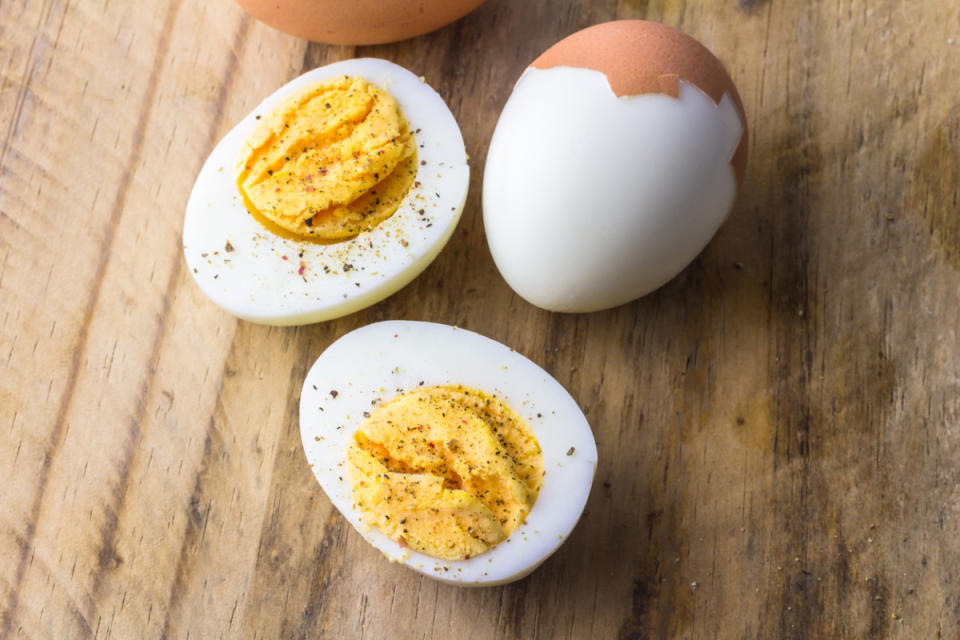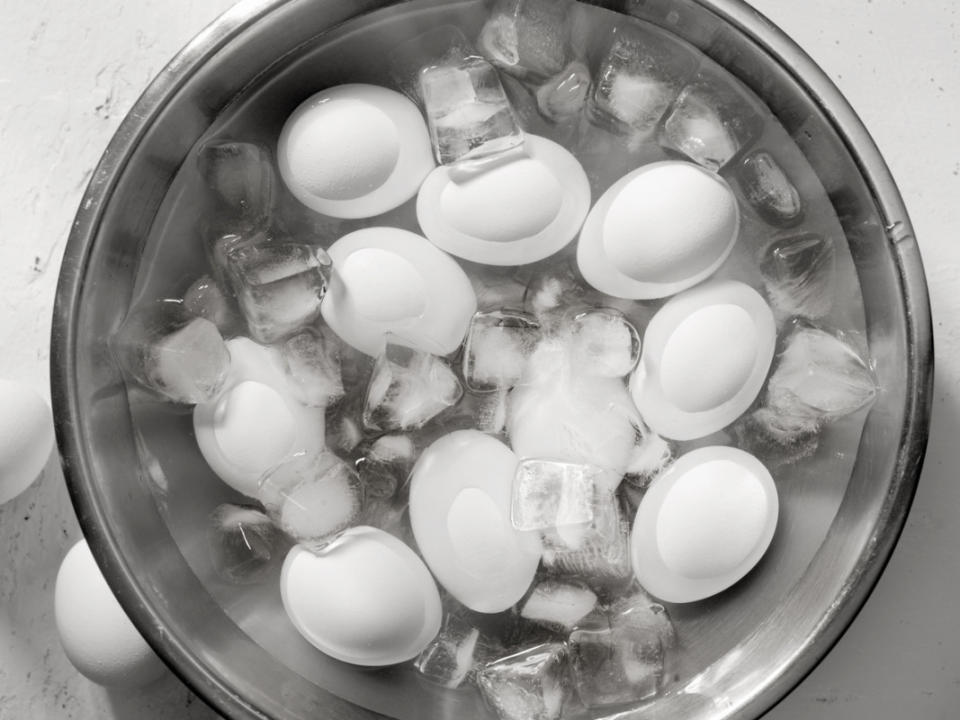The Easiest, Quickest, Totally Mess-Free Way to Peel a Hard-Boiled Egg

Peeled hard-boiled eggs with unpeeled eggs in bowl
The humble hard-boiled egg appears in both supporting and starring roles in countless dishes from cuisines around the world. They pop up around holidays (looking at you, Easter) and parties (hello deviled eggs), but are also a great everyday food. Hard-cooked eggs are delicious, a good source of protein, and inexpensive—even with recent price fluctuations. Plus, you can make hard-boiled eggs ahead and store them in the fridge for up to seven days, so they are meal-prep champs for breakfast, lunch, dinner and snacks.
The only real downside to hard-boiled eggs is that peeling them can be a real pain. Who hasn't struggled to peel a particularly tenacious shell and wound up with tattered-looking deviled eggs or, worse, bits of eggshell in your egg salad? I was determined to never eat—or serve!—another eggshell fragment, so I talked to a cooking expert, scoured the internet and put seven methods for peeling hard-boiled eggs to the test to find the absolute best way to peel hard-boiled eggs. Here's what I discovered.
Related: How to Tell If Your Eggs Are Bad, According to a Food Expert

iStock
7 Ways to Peel Hard-Boiled Eggs (and Which One is the Best)
After chatting with Shawn Matijevich, Lead Chef of Online Culinary Arts & Food Operations at the Institute of Culinary Education and digging around the internet, I decided to try these seven hard-boiled egg peeling methods. Here's how it went.
1. Blow Out the Egg: For this trick, you crack both the top and bottom of the egg and peel it slightly, then blow on the bottom until the egg pops out. First, this is gross. Second, it doesn't work—or at least it didn't for me. I wasn't able to budge the egg, no matter how hard I blew. Plus, you still have to peel the bottom and top of the egg before blowing it out, so it doesn't really save you any effort on the peeling front.
2. The Spoon Trick: For this method, you crack and peel the bottom of the egg, then gently wedge a spoon under the shell and turn it until the shell comes loose from the egg. This method worked better than I expected, but I still found some small bits of shell attached to the egg.
3. Smack and Roll: For this method, you smack the egg on the counter or a cutting board, then roll it until cracks form all over, then peel. This method worked quite well, but I don't think you really need to smack the egg—gently tapping the egg to crack it and then rolling it works fine.
4. Crack & Roll, Then Peel Under Cold Running Water: This method has you crack the egg as above, but then peel it under cool running water. This method made a mess in my sink, wasted water, and didn't make the egg any easier to peel.
5. Crack in a Bowl of Water and Then Peel Submerged: For this technique, you submerge the egg in a bowl of water and tap it against the side of the bowl to crack it, then peel it under water. This trick worked ok, but I found it wasn't as easy to crack the egg against the side of the bowl as it was to crack it on my cutting board or counter, and fewer cracks made it more difficult to peel.
6. Runner Up: Tap, Crack & Roll: Almost identical method #3 above, for this technique, you tap the bottom of the egg on a hard surface to crack it, then roll the egg on its side until it has cracks all over, and then peel, starting at the bottom of the egg. It worked slightly better than the smack-and-roll method and was my second favorite technique.
7. And the Winner... Tap, Roll, Then Peel in a Bowl of Water: For this method, which I cobbled together from my favorite parts of the other methods, you simply tap the bottom of the egg on the counter or a cutting board to crack it, gently roll the egg on its side until there are cracks all over, and then submerge the egg in a bowl of water to peel it. If you chill your eggs in an ice bath (more about that below), you can use the same water to peel them. For the best results, start peeling at the bottom of the egg, where the little pocket of air makes it easier to separate the shell from the egg. From there, the rest of the shell should just slip off. This is my new go-to method for peeling eggs, and I look forward to never crunching into a bit of stray eggshell again.
Related: 100 Best-Ever Egg Recipes

iStock
More Tips for Making Easy-to-Peel Hard-Boiled Eggs
There are also things you can do to make the peeling easier before the eggs are cooked. Here are my three top tips.
1. Start with Old Eggs
You may have heard that older eggs are easier to peel than fresh ones, and it's really true. I know this anecdotally from the mangled results of attempting to peel extremely fresh eggs (as in, laid the day before I cooked them), and science backs up my informal research. "Fresh eggs can be harder to peel because they have a lower pH level, which makes the egg white stick tightly to the membrane of the inner shell," explains Matijevich.
If you know you will be making hard-boiled eggs in the next few weeks, go ahead and pick up a carton now and stash them in the fridge, where they can be stored for three to five weeks past the date you purchased them, according to the USDA. If, like me, you're not the kind of person who looks at the calendar and says, "Let's see, I think I'll boil some eggs this time next month," then you can choose the oldest carton of eggs in your fridge or at the store by looking at the packing date.
Different from sell-by, use-by and expiration dates, the packing date is the exact date your eggs were put in the carton. You'll find the packing date on the end of the carton near the sell-by or expiration date. Packing dates are, confusingly, listed as Julian dates, which means they are three-digit numbers running from 001 for January 1 to 365 for December 31. Fortunately, the internet elves have created handy Julian date convertors. Or, even easier, you can just choose the carton with the lowest Julian number you can find.
2. Skip the Boiling Altogether
Regardless of how old your eggs are, the way you cook them can make them easier to peel. Many experts say that the best way to make easy-to-peel hard-boiled eggs is to steam them instead of boiling them. Just add a few inches of water to a pot, put in your steamer insert, bring the water to a boil, then add your eggs. In about 10 minutes you'll have perfectly cooked eggs with shells that slip off easily. The full method is described in this Parade deviled egg recipe, and it works beautifully.
Related: Easy Instant Pot Hard-Boiled Eggs
3. Give the Eggs an Ice Bath
No matter how you cook your eggs, plunging them into an ice bath to cool quickly as soon as the cook time is up will make them easier to peel. It will also help prevent that yucky-looking (but harmless) green ring that sometimes forms around the yolk.
Up next: 'I'm Only Making Jacques Pépin's 'French Style' Deviled Eggs From Now On'
